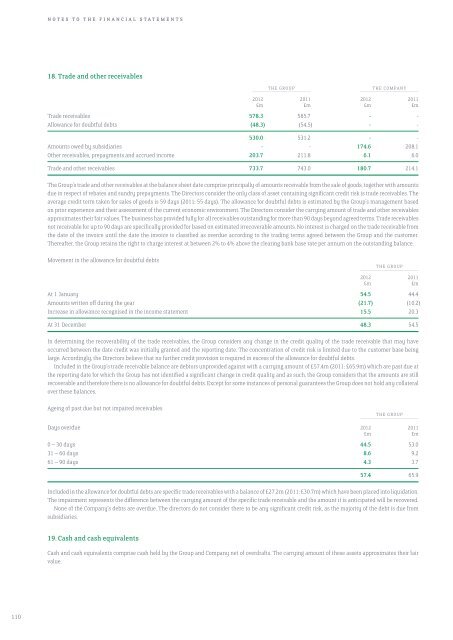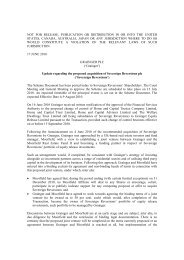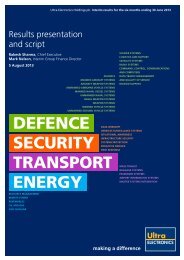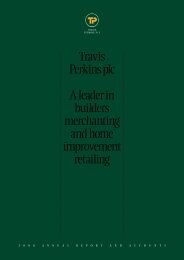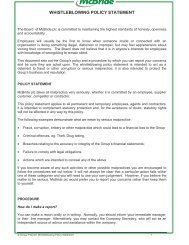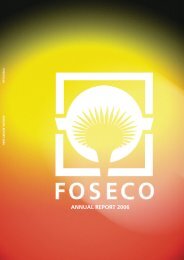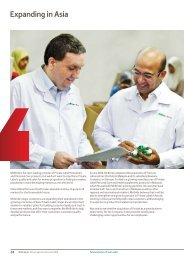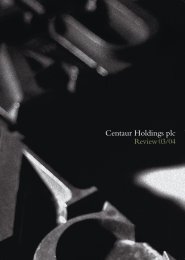Annual Report and Accounts - Hemscott IR
Annual Report and Accounts - Hemscott IR
Annual Report and Accounts - Hemscott IR
Create successful ePaper yourself
Turn your PDF publications into a flip-book with our unique Google optimized e-Paper software.
NOTES TO THE FINANCIAL STATEMENTS<br />
18. Trade <strong>and</strong> other receivables<br />
THE GROUP<br />
THE COMPANY<br />
–––––––––––––––––––––––––––––––––––––– ––––––––––––––––––––––––––––––––––––––<br />
2012 2011 2012 2011<br />
£m £m £m £m<br />
Trade receivables 578.3 585.7 - -<br />
Allowance for doubtful debts (48.3) (54.5) - -<br />
530.0 531.2 - -<br />
Amounts owed by subsidiaries - - 174.6 208.1<br />
Other receivables, prepayments <strong>and</strong> accrued income 203.7 211.8 6.1 6.0<br />
Trade <strong>and</strong> other receivables 733.7 743.0 180.7 214.1<br />
The Group’s trade <strong>and</strong> other receivables at the balance sheet date comprise principally of amounts receivable from the sale of goods, together with amounts<br />
due in respect of rebates <strong>and</strong> sundry prepayments. The Directors consider the only class of asset containing significant credit risk is trade receivables. The<br />
average credit term taken for sales of goods is 59 days (2011: 55 days). The allowance for doubtful debts is estimated by the Group’s management based<br />
on prior experience <strong>and</strong> their assessment of the current economic environment. The Directors consider the carrying amount of trade <strong>and</strong> other receivables<br />
approximates their fair values. The business has provided fully for all receivables outst<strong>and</strong>ing for more than 90 days beyond agreed terms. Trade receivables<br />
not receivable for up to 90 days are specifically provided for based on estimated irrecoverable amounts. No interest is charged on the trade receivable from<br />
the date of the invoice until the date the invoice is classified as overdue according to the trading terms agreed between the Group <strong>and</strong> the customer.<br />
Thereafter, the Group retains the right to charge interest at between 2% to 4% above the clearing bank base rate per annum on the outst<strong>and</strong>ing balance.<br />
Movement in the allowance for doubtful debts<br />
THE GROUP<br />
––––––––––––––––––––––––––––––––––––––<br />
2012 2011<br />
£m £m<br />
At 1 January 54.5 44.4<br />
Amounts written off during the year (21.7) (10.2)<br />
Increase in allowance recognised in the income statement 15.5 20.3<br />
At 31 December 48.3 54.5<br />
In determining the recoverability of the trade receivables, the Group considers any change in the credit quality of the trade receivable that may have<br />
occurred between the date credit was initially granted <strong>and</strong> the reporting date. The concentration of credit risk is limited due to the customer base being<br />
large. Accordingly, the Directors believe that no further credit provision is required in excess of the allowance for doubtful debts.<br />
Included in the Group’s trade receivable balance are debtors unprovided against with a carrying amount of £57.4m (2011: £65.9m) which are past due at<br />
the reporting date for which the Group has not identified a significant change in credit quality <strong>and</strong> as such, the Group considers that the amounts are still<br />
recoverable <strong>and</strong> therefore there is no allowance for doubtful debts. Except for some instances of personal guarantees the Group does not hold any collateral<br />
over these balances.<br />
Ageing of past due but not impaired receivables<br />
THE GROUP<br />
––––––––––––––––––––––––––––––––––––––<br />
Days overdue 2012 2011<br />
£m £m<br />
0 – 30 days 44.5 53.0<br />
31 – 60 days 8.6 9.2<br />
61 – 90 days 4.3 3.7<br />
57.4 65.9<br />
Included in the allowance for doubtful debts are specific trade receivables with a balance of £27.2m (2011: £30.7m) which have been placed into liquidation.<br />
The impairment represents the difference between the carrying amount of the specific trade receivable <strong>and</strong> the amount it is anticipated will be recovered.<br />
None of the Company’s debts are overdue. The directors do not consider there to be any significant credit risk, as the majority of the debt is due from<br />
subsidiaries.<br />
19. Cash <strong>and</strong> cash equivalents<br />
Cash <strong>and</strong> cash equivalents comprise cash held by the Group <strong>and</strong> Company net of overdrafts. The carrying amount of these assets approximates their fair<br />
value.<br />
110


